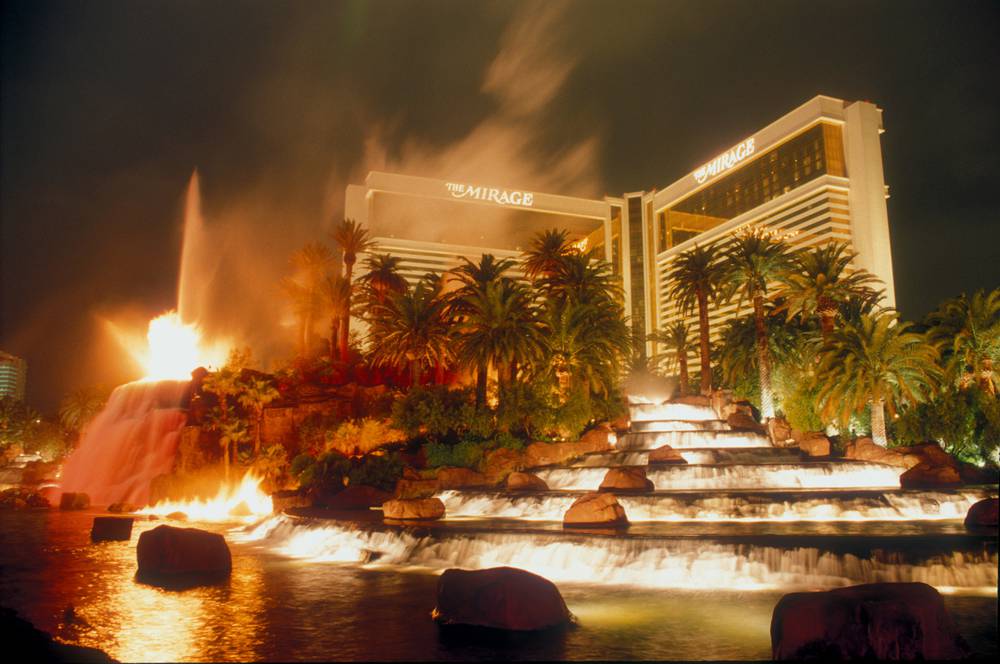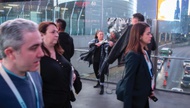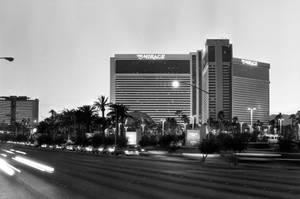Here’s a chilling thought, courtesy of the man who made it all possible: “Ask yourself, if there was no Mirage on the Strip, what would’ve happened?”
At the time, Steve Wynn sat with me in his vast, largely unadorned office half a world away in the Wynn Macau, which would open a week later, in September 2006. This wasn’t a thought exercise, though; Wynn was sketching out an alternative history for Las Vegas, one of his favorite exercises whenever his ideas for where the casino-resort universe should go are being questioned. Back then, he was in a flame war with Sheldon Adelson over how to proceed in the Chinese region, which would be so lucrative a few years later as to make both their companies Great Recession-proof.
The particulars of the dispute with Adelson, which made the big headlines when I conducted that interview, aren’t the most interesting part anymore. What is, however, is the close call Wynn had, perhaps, with mere mortality and the way one person’s decisions can change the face of a city. Wynn said that in 1984, as he was plotting his next move after success with the Golden Nugget, he saw opportunity not down on Las Vegas Boulevard but, strangely, across the railroad tracks on a plot of Union Pacific land that’s now home to the Clark County Government Center.
He offered the railroad $50 million for 50 acres over there, but, “They thought they could get $100 million. There was an idiot in the railroad, you know. Dope! He lost the whole opportunity, and they got bupkis. I would’ve built the Mirage down there. I went to the Strip in ’89, and then the Strip exploded.”
Try to imagine what the Mirage—or Victoria Bay, its working title earlier on—would have looked like, marooned over there, unwalkable for all but the most hearty yet also lacking in the vast empty spaces nearby that might entice competitors to build more.
“You would’ve been out there by yourself, though,” I said.
“I would’ve been by myself.”
“Would that have been a mistake?”
“I don’t know,” Wynn replied. “It didn’t happen.”
Once you hear about something like that, it’s hard to stop wondering. The wind blows just a little bit differently, and we all live in a whole other world. Wynn puts the Mirage Downtown and it’s as remarkable as a shooting star, marvelous to behold, but burnout is inevitable. His wife, Elaine, doesn’t become best friends with their Sun Valley, Idaho, neighbor Barbara Zax, wife of then-Hilton vice president Stan Zax who, it so happened, was a cousin of financier Michael Milken. And maybe the Wynns don’t raise the ungodly sum of $600 million to build the fanciful place at all.
Wynn now takes great pride in having known, as Steve Jobs and Henry Ford before him, what the people wanted before they did. But other Vegas visionaries, men with big ideas and serious artistic genius, ended up broke or nearly forgotten. Wynn puts the Mirage west of Downtown and perhaps we compare him today to Bob Stupak?
These are only some of the reasons why anniversaries like this—the Mirage’s 25th birthday is November 22—are important to recognize. It’s not just a media event, although it’s certainly that, because even the anniversaries of non-transformative things are treated that way nowadays. But for really important moments like this, examining the historic pivot—complete with what-ifs like the unthinkable one Wynn laid out for me that day—is crucial.
To comprehend the significance of the gambit that was the Mirage, it helps to remember the awe and innocence with which it made its impression, not simply on hotel guests or gamblers but on any soul who meandered through—and how novel a concept that was. Between 1989 and 1996, when I first stepped inside the Mirage, other fanciful resorts popped up from the Excalibur to the Luxor to, yes, Wynn’s second Strip effort, Treasure Island, which Elaine Wynn once told me she regarded as “an abortion.”
While all of those places were successful in their own ways, even in 1996 walking inside the Mirage for the first time remained a singular, sensory, emotional Las Vegas experience. I remember disbelieving the friend who brought me there in the early weeks of my Vegas life, when he insisted that all that vegetation in the atrium was living flora. Even now, the symphony of trickling and spritzing water fills my ears. The resort’s street-side volcano, while creative and exciting, was also, obviously, the type of man-made spectacle one could reasonably expect from a place as supposedly manufactured as Las Vegas. The actual mirage was that first-timer’s discovery—that the lush atrium sitting in the middle of the world’s driest desert was, in fact, real.
That atrium, even more than the rest of what the Mirage offered, set the place apart in its effort to be something more than the sum of its parts. Because what Wynn knows is that he didn’t actually invent anything more than a different presentation of elements that already existed in Las Vegas. He embraced the claims that the Mirage was some wild, unhinged financial risk, he told me in 2009, because they were being promulgated by people like Caesars World CEO Henry Gluck and President Terry Lanni, who wanted him to fail.
“We had a book that was a black book, a folder, that was about 120 pages,” Wynn explained in an interview in advance of the opening of CityCenter. “In it was an exhaustive examination of three hotels in Las Vegas: the Hilton, Bally’s and Caesars [Palace]. Each of those studies showed how food and beverage and convention sales at the Hilton were ‘X’ and worked. They showed how retail and tour and travel at Bally’s produced a result. And it showed how entertainment and fanciful public areas had worked at Caesars. And in this book was the most comprehensive financial analysis that showed that what we were doing already existed in Las Vegas in three separate hotels: 2,100 rooms at the Hilton, 2,000 rooms at Bally’s and 1,300 rooms at Caesars. Every single aspect of our program was responsible for huge success at one part of those hotels or the other, but they did not exist in one place.”
Plus an atrium, a softer color palette throughout, coziness. Wynn’s decisions to include the flamboyant Roger Thomas and the classy Elaine Wynn intimately in the design were critical distinctions that made the place warmer and more welcoming than, say, the voluminous MGM Grand. I also believe that Wynn’s degenerative eye disease, retinitis pigmentosa, which has been reducing his field of vision for decades, gave the man an unusual ability to appreciate that while things in Vegas needed to be big in order to be profitable, they also had to be small and manageable enough to feel human.
“You remember how when you walked into the Mirage, how small it was?” Wynn said during our Macau conversation. “You came in through the middle in the atrium, and I put the [gaming] tables right in front of you? I want to build a business from the center out, so that people are always in a busy place, full of life. So I made the hallways real narrow through the atrium. I squeezed people so that less could look like more, so that it could grow from the middle out.”
He appreciated the contradictory desires for grandeur and intimacy, which is why he and builder Tony Marnell Jr. created the Y-shaped hotel tower with the central elevator banks. It seems eminently logical now, a way of reducing the long hike to the farthest rooms, and everyone on the Strip would do it in the coming decades.
“Steve was very focused, as he always is, on making big places feel smaller to the customer so they wouldn’t get out of control,” Marnell told me for a Vegas Magazine profile in 2008. The Y-shape also had the added bonus, also dictated by Wynn, of making it impossible for guests to see into one another’s rooms as they could in, say, Caesars Palace’s many parallel towers.
Wynn has long vacillated between insisting that he knew the Mirage would be a groundbreaking hit all along and telling an anecdote about calling his top lieutenant, Bobby Baldwin, in a fit of insecurity days before the opening to ask if they should advertise more. But even if Wynn both believed in his vision and had the all-too-human experience of letting some self-doubt creep in, he couldn’t have anticipated what the Mirage would mean.
In its first full year, he told me, the place grossed $800 million—“$400 million gaming, $400 million non-gaming. No one had ever won $300 million [in the gaming take]. Caesars did $300 million total that year, $100 million of it non-gaming. We did $800 million! It was the $400 million in non-gaming that caused the $400 million of gaming!”
Today, again, we take it on faith that Las Vegas has survived several recessions, along with the onslaught of tribal and regional casinos while Reno, Atlantic City and others haven’t, because of the Vegas-ness of it all. It wasn’t always so obvious.
Perhaps the world would have figured all of this out without the advent of the Mirage, the same way the world would have eventually come to the assembly line without the Model T. But that’s a revisionist’s version of the past, not one that accepts the sequence of what actually occurred. And that is this: Wynn built the Mirage, which revolutionized the idea of what both a casino and a hotel could be. That kicked off a building boom of unparalleled enormity and scale that, with only brief siestas, continued unabated until the Cosmopolitan opened in 2010. Many others would innovate, too—Adelson, most notably, saw the fortunes to be made in convention travel—but who would have put up the money to build any of it if the Mirage had flopped the way, say, the Stratosphere did?
Appropriately, the Mirage has receded just far enough from the front burner of Las Vegas to now be available for and worthy of this nostalgia moment. Not, however, that it has received its proper due from its owners this time around, either. Its 10th anniversary was swallowed whole by the opening of the Bellagio the year before and the frenzy over the imminent new millennium. When it turned 20, its parent company was weeks from opening CityCenter, Jim Murren’s own stab at a Wynn-style Vegas reinvention, and eight months from changing its name from MGM Mirage to MGM Resorts, so emphasis on this property was not of great interest. Likewise, Murren and the gang still seem reticent to celebrate the historic gem they own, planning no public events or marketing pushes. That could be because nobody in Vegas likes to emphasize something getting old. Or, perhaps, Murren still resents the fact that his CityCenter brainstorm did not place him in the Wynn-Adelson pantheon as he hoped.
It’s too bad, because Murren and his predecessor, Lanni, have capably honored the Mirage legacy in the way they’ve managed the property, even as they have occasionally disrespected Wynn himself. It was inevitable that it would shift from top-of-the-market to somewhere smack in the middle, no longer the most luxurious but continually well-rounded and satisfying, like a Hershey bar on a shelf of ever-fancier candies. They spruced up the volcano a bit, switched around the dining options and replaced Siegfried & Roy with the triumphant and beautiful The Beatles Love. But it remains far more recognizable than, say, the Caesars Palace of 15 years ago.
“That’s the story here,” Wynn said to me in Macau that day. “It’s not very complicated. But you know what? Big ideas never are.”
I tend to disagree. Big ideas are always complicated, until they succeed, until they work out, until they make someone very rich and change the status quo. Then, they seem like the most obvious thing in the world. Today, the Mirage seems so insanely logical. But it wasn’t.
Running the show: Then: Steve Wynn. Now: MGM Resorts.
Headliner: Then: Siegfried & Roy. Now: Terry Fator.
Volcano eruption: Then: 3 minutes, 21 seconds. Now: 5 minutes, 40 seconds.
Fancy food: Then: Renoir by Alex Stratta. Now: Heritage Steak by Tom Colicchio.
Cirque show: Then: Nouvelle Experience. Now: The Beatles Love.
Hollywood reference: Then: Vegas Vacation. Now: The Wolf of Wall Street.
Spirit animal: Then: White tigers. Now: White tigers' cubs.








